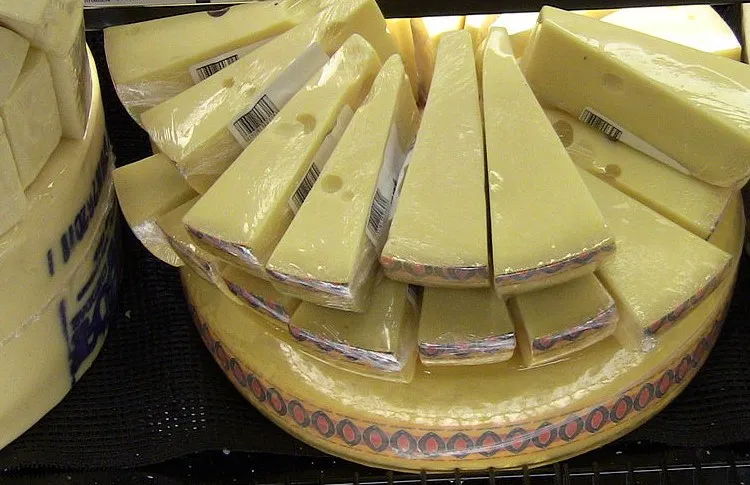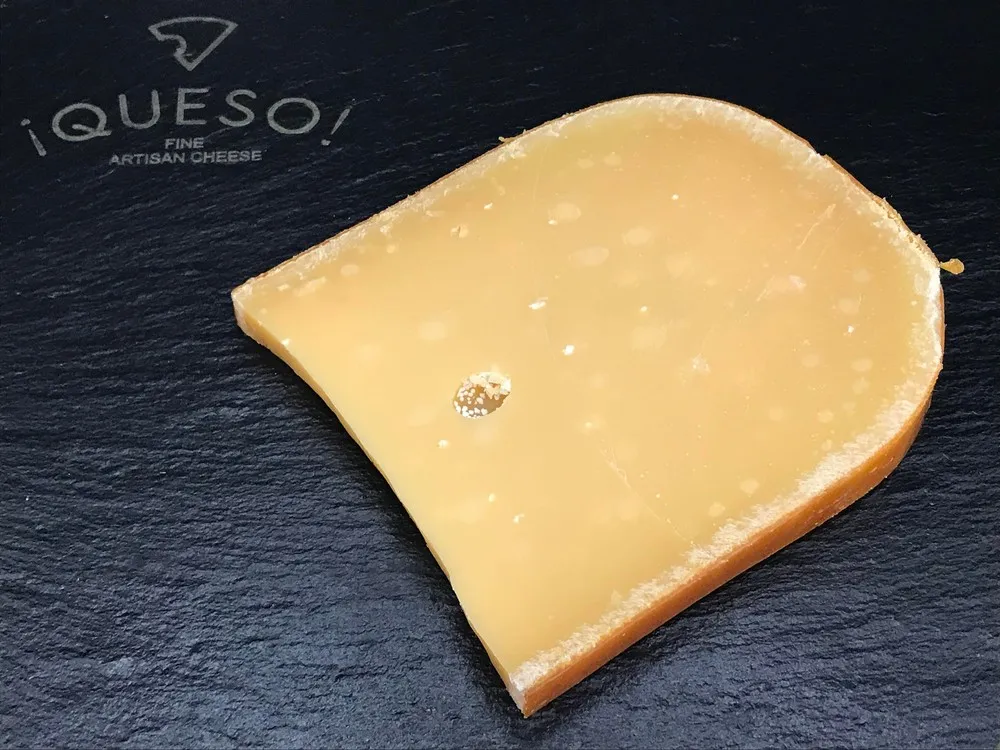Jarlsberg
What Is Jarlsberg Cheese? What Does Jarlsberg Cheese Taste Like?
Jarlsberg is a mild, semi-soft cow's milk cheese of Norwegian origin. It is popular enough to be produced in Norway, Ireland, and the USA; it resembles a Swiss Emmental with distinctive, open, and irregular eyes.
Jarlsberg often finds itself marketed as a Swiss cheese because of its close resemblance to Emmentaler; in reality, it is a much sweeter and more substantial cheese with marked dissimilarities.
Beneath the yellow-wax rind of Jarlsberg is a semi-firm yellow interior that is buttery, rich in texture, with a mild, nutty flavor. It is an all-purpose cheese, suitable for cooking as well as eating as a snack. Jarlsberg tastes delicious with sandwiches, fondues, quiches, and hot dishes. The versatility of the cheese is appreciated well beyond the Scandinavian world in the US, UK, and Europe.
Jarlsberg is a unique culinary delight, available in a variety of forms, and offering something for everyone. Whether you prefer it in wheels, slices, wedges, minis, or random-weight pieces, you can enjoy the unique taste and texture of this versatile cheese.
Indeed, its distinctive taste, which combines a blend of rich nuttiness and a hint of sweetness, sets it apart from other cheeses. This unique flavor profile, coupled with its creamy texture, has won the hearts of cheese connoisseurs worldwide.
What Does Jarlsberg Cheese Taste Like?
When it comes to taste, Jarlsberg offers a unique and enjoyable flavor profile. It has a rich and nutty taste with a hint of sweetness. The cheese is smooth and creamy, making it incredibly satisfying to bite into. Its flavor is often compared to Swiss cheese but with a slightly milder and less sharp taste.
The mildness of Jarlsberg cheese makes it a versatile canvas for culinary creativity. Whether you're slicing it for a classic sandwich, melting it in a gourmet grilled cheese, or adding it to a sophisticated cheese platter, the distinctive taste of Jarlsberg will undoubtedly elevate your dish to new heights.
One of the reasons behind the delightful taste of Jarlsberg cheese lies in its production process. This Norwegian cheese is made from cow's milk and follows a traditional recipe that includes a unique blend of bacteria cultures. These cultures contribute to the cheese's unique flavor profile, giving it a slightly tangy undertone that complements its nutty notes.
Furthermore, the aging process of Jarlsberg cheese plays a crucial role in developing its taste. The cheese is aged for a minimum of three months, allowing its flavors to mature and intensify. During this aging period, the cheese develops a complex depth of flavor, enhancing its overall richness and creating a satisfying taste experience.
Jarlsberg cheese, with its distinctive nutty and slightly sweet flavor, has become a popular choice for cheese lovers around the world. Its smooth and creamy texture makes it a versatile cheese that can be enjoyed on its own or used in a variety of dishes. One of the key factors that sets Jarlsberg apart from other cheeses is its iconic large holes, known as "eyes." These holes are formed during the cheese-making process when carbon dioxide is released by bacteria, creating the characteristic round openings. The size and distribution of these holes can vary, adding to the unique appearance of Jarlsberg. In addition to its delicious taste and texture, Jarlsberg is also a good source of calcium and protein, making it a nutritious choice for those looking to add more dairy to their diet. Whether melted on a sandwich, grated over pasta, or simply enjoyed with crackers and fruit, Jarlsberg cheese is sure to delight your taste buds with its rich and complex flavors.
How Long Does Jarlsberg Cheese Last?
Like many other types of cheese, the shelf life of Jarlsberg largely depends on how it's stored.
When stored properly in the refrigerator, an unopened block or wheel of Jarlsberg can last up to 4-6 weeks. However, once you open the package, it's best to consume it within 1-2 weeks for optimal freshness and taste.
To extend the lifespan of Jarlsberg cheese, it's essential to keep it adequately wrapped or stored in an airtight container. This ensures that it remains protected from air exposure, which can lead to spoilage.
Jarlsberg cheese, a mild, semi-soft cheese with a slightly sweet and nutty flavor, originates from Norway. It is a versatile cheese that can be enjoyed on its own, paired with fruits and nuts, or melted in sandwiches and dishes. Known for its characteristic large holes, Jarlsberg is often compared to Swiss cheese but with a distinct taste all its own.
For cheese enthusiasts looking to experiment with Jarlsberg, it can also be used in a variety of recipes such as quiches, fondues, and cheese boards. Its creamy texture and mild taste make it a popular choice for both cooking and snacking. When incorporating Jarlsberg into dishes, it's essential to consider its melting properties and adjust cooking times accordingly to enjoy its rich flavor profile fully.
Where Does Jarlsberg Cheese Come From?
As mentioned earlier, Jarlsberg has its origins in Norway.
It was first created in the mid-1950s by a group of Norwegian researchers who aimed to develop a cheese with a similar taste and texture to Swiss Emmental.
Today, Jarlsberg is produced both in Norway and various other countries around the world. However, authentic Jarlsberg is still made in Norway, using the same traditional methods and high-quality ingredients.
How Much Protein in Jarlsberg Cheese?
If you're watching your protein intake, you'll be glad to know that Jarlsberg cheese is a good source of protein. A 1-ounce (28g) serving of Jarlsberg cheese contains 7.6 grams of protein.
Protein is an essential nutrient that plays a vital role in various bodily functions. It is necessary for muscle growth, repair, and overall health. Adding Jarlsberg cheese to your diet can be a tasty way to incorporate more protein into your meals.
Jarlsberg Cheese Calories and Nutrition
While Jarlsberg cheese offers a mouthwatering taste, it's worth considering its calorie and nutritional content.
A 1-ounce (28g) serving of Jarlsberg cheese typically contains around 111 calories, making it a relatively moderate option in terms of calorie intake.
In addition to protein, Jarlsberg cheese also provides essential nutrients like calcium and vitamin D. Calcium is crucial for maintaining strong and healthy bones, while vitamin D aids in calcium absorption.
It's always important to remember that moderation is key when it comes to enjoying any type of cheese, including Jarlsberg. Incorporating it into a well-balanced diet can add flavor and nutrition to your meals, ensuring you can savor its delicious taste while still maintaining a healthy lifestyle.
In conclusion, Jarlsberg cheese is not just a delightful and unique variety of cheese but also a nutritious addition to your diet.
With its rich, nutty taste and creamy texture, it's a favorite among cheeses. Its protein and nutritional content make it a favorable choice for those looking to boost their protein intake. So, next time you're looking for a delectable cheese to enhance your meals, give Jarlsberg a try and experience its exceptional flavor and health benefits for yourself.

Over 200,000 page views per month, Put your store on our map!
Contact UsOther cheeses from Norway:
Jarlsberg cheese, a versatile and popular cheese variety, is celebrated for its smooth, creamy texture and nutty flavor.
Originating in Norway, it has earned global recognition for its adaptability in various culinary applications. However, there might be times when you're in search of a substitute for Jarlsberg cheese. Whether it's …
Read MoreJarlsberg Q & A
-
Is Jarlsberg Cheese Lactose-Free?
If you struggle with lactose intolerance, you might be wondering if Jarlsberg cheese is a suitable option for you. …
Read More -
Is Jarlsberg Cheese Vegetarian?
If you're adhering to a vegetarian diet, you'll be glad to hear that Jarlsberg cheese is generally considered vegetarian-friendly. …
Read More -
Is Jarlsberg Cheese Gluten-Free?
If you follow a gluten-free diet, you'll be happy to know that Jarlsberg cheese is typically gluten-free. It doesn't …
Read More -
Does Jarlsberg Cheese Melt?
Jarlsberg cheese is renowned for its excellent melting properties. When heated, it becomes irresistibly gooey and develops a rich, …
Read More -
How To Store Jarlsberg Cheese
To prolong the shelf life and maintain the quality of your Jarlsberg cheese, proper storage is crucial. The best …
Read More -
How Long Can Jarlsberg Cheese Sit Out?
Like any perishable food, Jarlsberg cheese should not be left out at room temperature for an extended period. Bacteria …
Read More -
Can You Freeze Jarlsberg Cheese?
If you find yourself with excess Jarlsberg cheese or want to buy it in bulk, freezing it can be …
Read More -
Can Dogs Eat Jarlsberg Cheese?
As with cats, dogs are primarily meat-eaters and should have a diet that consists mainly of animal proteins. …
Read More -
Can Cats Eat Jarlsberg Cheese?
If you're a cheese lover with a furry feline friend, you might wonder if it's safe to share your …
Read More -
Can You Eat Jarlsberg Cheese While Pregnant?
Pregnancy is a time when many dietary considerations need to be taken into account. Jarlsberg cheese is generally safe …
Read More






